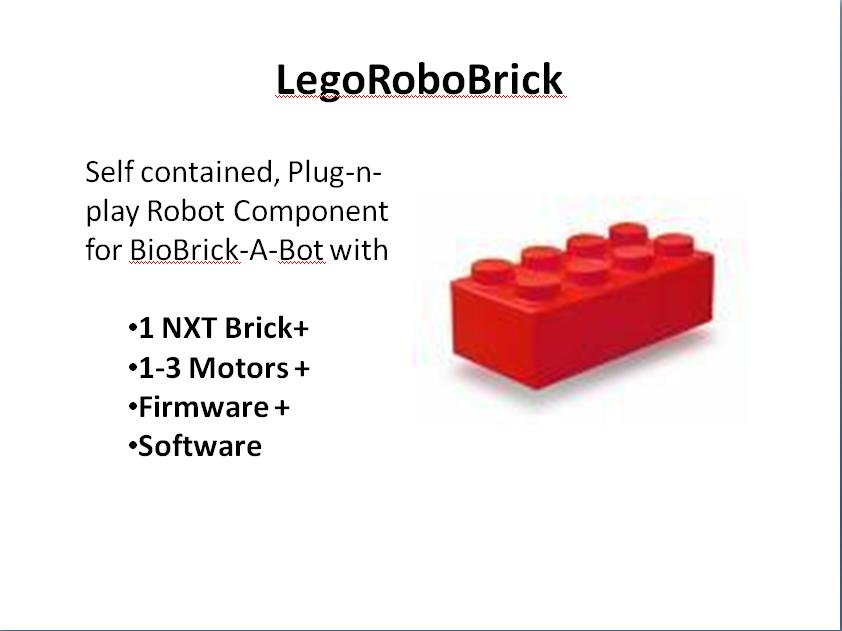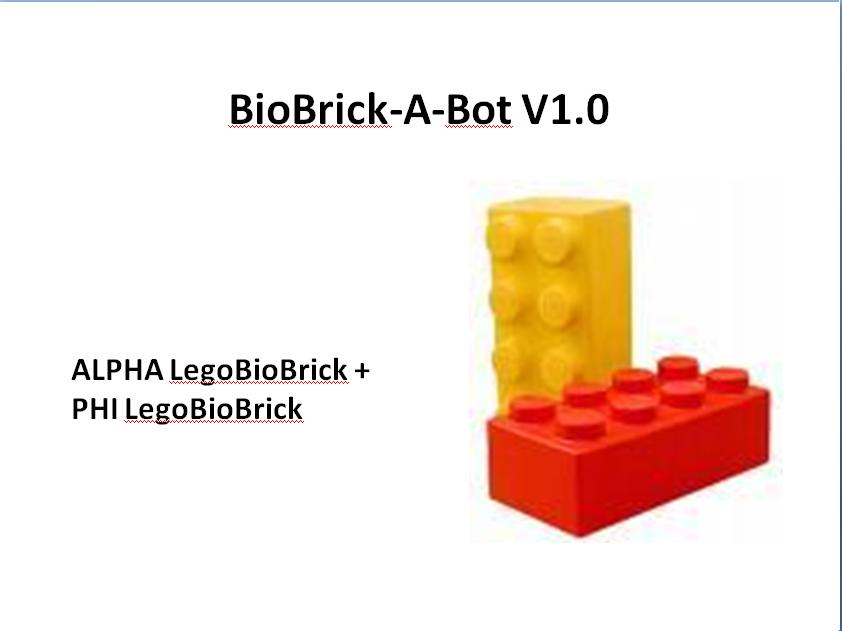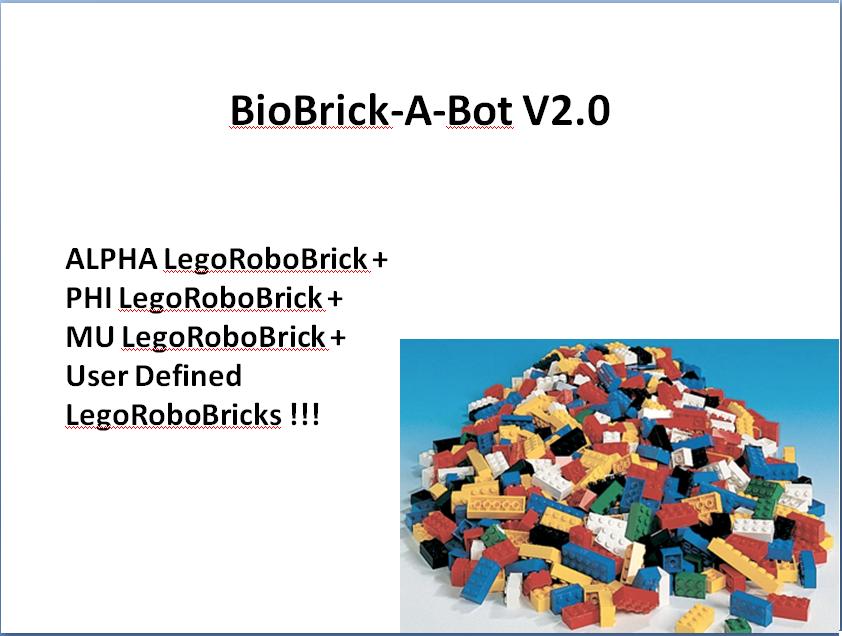Team:Washington-Software/Collaboration
From 2009.igem.org
(→Collaboration with other iGEM Team) |
(→Ways to Facilitate Collaboration) |
||
| Line 5: | Line 5: | ||
===Ways to Facilitate Collaboration=== | ===Ways to Facilitate Collaboration=== | ||
<hr> | <hr> | ||
| - | BioBrick-A-Bot is a prototype of a automated BioBrick DNA assembling robot (hereafter called ‘bot’) | + | BioBrick-A-Bot is a prototype of a automated BioBrick DNA assembling robot (hereafter called ‘bot’). We have demonstrated with a proof-of-principle that it works. This is only the first step. Once this is done, other iGEM teams can build and customize their own, inexpensive bots. Collaboration is made extremely easy because of the 3 design philosophies below: replicability, interchangeability and extensibility. |
<h4>Replicability</h4> | <h4>Replicability</h4> | ||
The cost of building your own bots is about US $600/-. The Lego Parts are easily accessible. We will provide hardware construction instructions in a document form, so that iGEM teams can follow and build ALPHA and PHI modules. We will provide RobotC source codes to iGEM teams too. So, It is easy to replicate BioBrick-A-Bot Model C that we show in the Proof-of-Principle Demo. | The cost of building your own bots is about US $600/-. The Lego Parts are easily accessible. We will provide hardware construction instructions in a document form, so that iGEM teams can follow and build ALPHA and PHI modules. We will provide RobotC source codes to iGEM teams too. So, It is easy to replicate BioBrick-A-Bot Model C that we show in the Proof-of-Principle Demo. | ||
| Line 12: | Line 12: | ||
<h4>Extensibility</h4> | <h4>Extensibility</h4> | ||
The next phase in collaboration is actually extensibility. This would mean adding new functionalities to BioBrick-A-Bot, by developing new Modules. Currently, we have developed only 2 Modules, called ALPHA and PHI. We planned to build a third Module called MU as described in V2.0 of the specification. Other teams are also encourage to build and share additional BioBrick-a-Bot Modules as well. In the next version of BioBrick-A-Bot, we will implement Single-Master-Multiple-Slaves Synchronization, to support 3 or more Modules, with ALPHA as the master. | The next phase in collaboration is actually extensibility. This would mean adding new functionalities to BioBrick-A-Bot, by developing new Modules. Currently, we have developed only 2 Modules, called ALPHA and PHI. We planned to build a third Module called MU as described in V2.0 of the specification. Other teams are also encourage to build and share additional BioBrick-a-Bot Modules as well. In the next version of BioBrick-A-Bot, we will implement Single-Master-Multiple-Slaves Synchronization, to support 3 or more Modules, with ALPHA as the master. | ||
| + | |||
===Collaboration with other iGEM Team=== | ===Collaboration with other iGEM Team=== | ||
<hr> | <hr> | ||
Revision as of 05:57, 21 October 2009

| Home | Team | Project | Modeling | Notebook | Challenges | Miscellaneous |
|---|
| Collaboration | Achievements | Future (V 2.0 Specs) | Downloads | Safety |
|---|
Contents |
BioBrick-A-Bot: Sharing and Collaboration in Automated BioBrick Assembly
(New Approach to Human Practice in Synthetic Biology)
Ways to Facilitate Collaboration
BioBrick-A-Bot is a prototype of a automated BioBrick DNA assembling robot (hereafter called ‘bot’). We have demonstrated with a proof-of-principle that it works. This is only the first step. Once this is done, other iGEM teams can build and customize their own, inexpensive bots. Collaboration is made extremely easy because of the 3 design philosophies below: replicability, interchangeability and extensibility.
Replicability
The cost of building your own bots is about US $600/-. The Lego Parts are easily accessible. We will provide hardware construction instructions in a document form, so that iGEM teams can follow and build ALPHA and PHI modules. We will provide RobotC source codes to iGEM teams too. So, It is easy to replicate BioBrick-A-Bot Model C that we show in the Proof-of-Principle Demo.
Interchangeability
Interchangeability is the next logical step to collaboration and sharing. We have shown a proof-of-principle that it is possible to build 2 different physical implementation of ALPHA module, with different geometric configuration and physical dimension, and still run the same software. Hence various other iGEM teams are encourage to customize their own variants of the ALPHA modules. These ALPHA modules should work seamlessly with the software provided. iGEM teams are also encourage to check in new ALPHA implementation in the registry, so as to facilitate sharing and collaborations.
Extensibility
The next phase in collaboration is actually extensibility. This would mean adding new functionalities to BioBrick-A-Bot, by developing new Modules. Currently, we have developed only 2 Modules, called ALPHA and PHI. We planned to build a third Module called MU as described in V2.0 of the specification. Other teams are also encourage to build and share additional BioBrick-a-Bot Modules as well. In the next version of BioBrick-A-Bot, we will implement Single-Master-Multiple-Slaves Synchronization, to support 3 or more Modules, with ALPHA as the master.
Collaboration with other iGEM Team
Raik's Barcelona Team
One of our external team advisors, Raik Gruenberg, is interested to start a new team in Barcelona next year and replicate the existing ‘bot’ that we have. This is a good first step. Raik has also written some procedures for performing [http://openwetware.org/wiki/Prbbbb:fusion_assembly_v1 fusion assemblies]. We will attempt to collaborate with his team and get our ‘bot’ to automate the procedure above too.
University of Washington Wet-Lab Team
We have also presented BioBrick-A-Bot to the University of Washington Wet-Lab Team (See Picture Gallery ). Next year we could look into using one of our ‘bots’ to automate some of the mundane tasks in BioBrick assemblies.
 "
"


